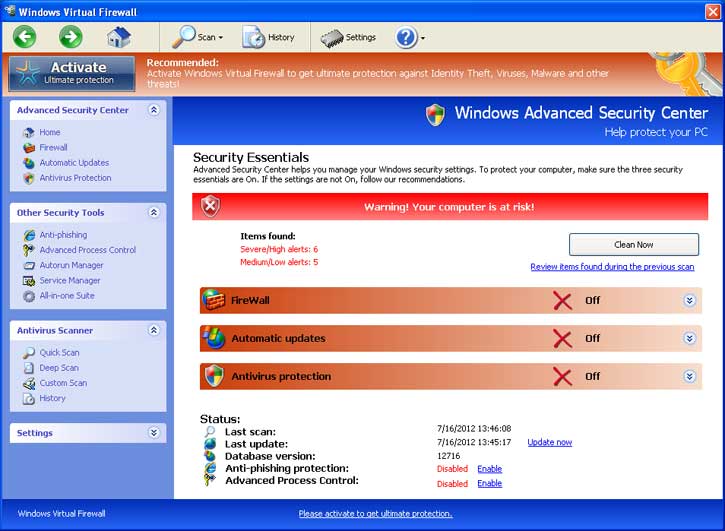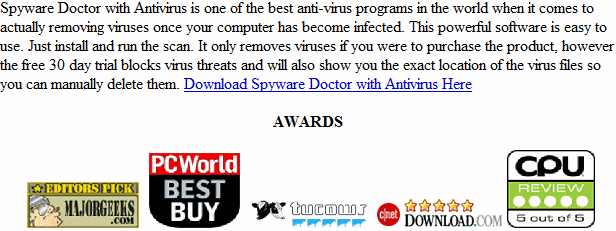Windows Virtual Firewall
Welcome! If you’re reading this guide, you’ve been infected with Windows Virtual Firewall. Infections of this kind pretend to be legitimate security products in order to fool the end user into purchasing them. Most frequently, infections of this kind will do this by making it difficult to use your computer, blocking applications you use frequently from running and interfering with the operation of your antivirus. They may also alter the search provider settings in your browser to make it more difficult to find things like this guide! This client is a clone of Anti-Spyware, XP Home Security 2012, XP Anti-Virus 2012 and XP Security 2012 as well as Win 7 Anti-Spyware, Win 7 Home Security 2012.
How Did I get infected with Windows Virtual Firewall?
Infections of this variety generally come from infected ads on web-pages, usually without the knowledge of the website’s administrator. Usually you won’t even be asked if you want to install anything, this type of infection exploits security flaws in Flash player and your browser to install themselves without your knowledge. However, if this is indeed the case, you should consider upgrading to a better antivirus.
How Much Damage is Windows Virtual Firewall Doing?
Similar to most variants of this infection, the biggest issue that it causes with your Windows installation is a disassociation of executable files within the operating system. This is why you’re getting that pop-up asking you what you would like to use to open every program you try to run. This is because information contained in the registry that tells Windows how to deal with files of this type has been damaged as a result of the infection. The good news is that it’s a pretty simple fix, and we’ve posted it below in the guide.
Windows Virtual Firewall

» Download Windows Virtual Firewall Removal Software
How to Remove Windows Virtual Firewall?
This article will give an overview of three main methods to remove the infection: 1. Use Anti-virus software (Note you may need to follow the manual guide to start so you can install a client.)
2. Hire an expert ( We Recommend http://www.pcninja.com. This is a remote computer repair company)
3. Remove this threat yourself following our manual removal guide.
Automatic Windows Virtual Firewall Removal
Online Windows Virtual Firewall Removal Service
Windows Virtual Firewall Manual Removal Procedures
Step 1. If you are unable to run any executable programs at all this may be from the virus changing your registry settings. If this is the case you may need to use this patch. It is only for Windows 7 computers. Download Win 7 Fix exe Issue here.
Step 2. You need to stop and delete the main .exe file that is running You should be able to locate this file at.
- %AppData%\Protector-[random 3 chars].exe
- Exmaple: Protector-123.exe
Keep in mind that the USERNAME will be your user name
The file is called Protector-[random 3 chars].exe. Expect this name to change over time.
Once you locate the file you will need to re-name the file. To do this you can right click on the file named and select “Re-name”. Name it whatever you want. Once done re-start your computer. Next time you boot up the virus should not be running. Now you should be able to delete the file name.
At this time you should run a full virus scan. We Recommend Spyware Doctor with Antivirus. However you can use any client you trust the most. To see a list of other clients we recommend check out our Anti-virus Reviews section.
Windows Virtual Firewall Registry Removal Procedures
We never recommend that users edit the registry unless they’re entirely comfortable doing so, since it’s entirely too easy to cause major damage to your
operating system. Furthermore, aside from the issue that this infection creates with executable files, there isn’t any reason to edit the registry. If you think
that your registry is damaged or could just use some cleaning, you may want to use a registry cleaner like PC Health Advisor Here to clean out the registry and scan for other malware. You can also read all or registry cleaner reviews
Windows Virtual Firewall Directories:
Windows 7 / Windows Vista
- %AppData%
%AppData% is a home directory listing that will take you directly to the users Application Data directory. This should be checked on each users account
that is affected by the infection.
If you require advanced help or just want an expert to remove the virus than use pcninja.com. The charge is under a hundred bucks and they can often get started right away. These are real experts when it comes to malware and virus removal.
Related Article Keywords: Windows Virtual Firewall, Remove Windows Virtual Firewall, Windows Virtual Firewall Removal, How to Remove Windows Virtual Firewall


With a yahoo e-mail problem, I ended up talking with a tech from Virtual Techmart., non American.He scared this old man and said I needed their 5 layer Firewall. Upshot was promised a detailed written memo explaining how I was better protected, etc. I stupidly relented for a fee and supposedly this was done. Of course I have never received any explanation. To me, I was scammed. Can a qualified tech look at my computer and tell what, if anything was done?
Did you not say it was free?
Not sure how you where scammed if they did not charge you. As far as telling what was done that will not be knowable to a large extent. However you can quickly and easily scan your computer with an antivirus client such as the free Microsoft Security Essentials or another AV client and see if there is anything malicious on your computer.
As for a 5 Layer firewall, sounds fishy. No such thing on normal computers but they may call it a 5 layer firewall even with just a regular firewall (Already built into Windows and your router). I feel for you Rex if you paid for the service but that is part of life. If you paid on a credit card call the credit card company and clearly state you where scammed. Don’t say maybe scammed just say scammed.